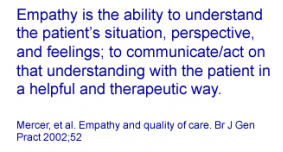March 16th, 2011 by StevenWilkinsMPH in Opinion, Research
3 Comments »

 Is anyone else tired of hearing about how important empathy is in the doctor-patient relationship? Every other day it seems a new study is talking about the therapeutic value of empathy. Enough already!
Is anyone else tired of hearing about how important empathy is in the doctor-patient relationship? Every other day it seems a new study is talking about the therapeutic value of empathy. Enough already!
It’s not that I don’t believe that empathy is important — I do. I also believe the data that links physician empathy with improved patient outcomes, increased satisfaction, and better patient experiences.
A recent study released in Academic Medicine reported that “patients of physicians with high empathy scores were significantly more likely to have good control over their blood sugar as well as cholesterol, while the inverse was true for patients of physicians with low scores.”
Findings from this study by Hojat, et al. are consistent with a 2009 study by Rakel, et al. which found that among patients with the common cold, those with physicians displaying high empathy had a significantly shorter duration of illness and trend toward lesser severity of illness and higher levels of immune response compared to those patients whose physician displayed less empathy. Read more »
*This blog post was originally published at Mind The Gap*
March 10th, 2011 by Harriet Hall, M.D. in Opinion, Research
No Comments »

A new article in the Journal of Women’s Health by Westhoff, Jones, and Guiahi asks “Do New Guidelines and Technology Make the Routine Pelvic Examination Obsolete?”
The pelvic exam consists of two main components: The insertion of a speculum to visualize the cervix and the bimanual exam where the practitioner inserts two fingers into the vagina and puts the other hand on the abdomen to palpate the uterus and ovaries. The rationales for a pelvic exam in asymptomatic women boil down to these:
- Screening for chlamydia and gonorrhea
- Evaluation before prescribing hormonal contraceptives
- Screening for cervical cancer
- Early detection of ovarian cancer
None of these are supported by the evidence. Eliminating bimanual exams and limiting speculum exams in asymptomatic patients would reduce costs without reducing health benefits, allowing for better use of resources for services of proven benefit. Pelvic exams are necessary only for symptomatic patients and for follow-up of known abnormalities. Read more »
*This blog post was originally published at Science-Based Medicine*
March 9th, 2011 by Bryan Vartabedian, M.D. in Better Health Network, Opinion
1 Comment »

 How comfortable are we with uncertainty? I struggle with this question every day. I treat children with abdominal pain. Some of these children suffer with crohns disease, eosinophilic esophagitis, and other serious problems. Some children struggle with abdominal pain from anxiety or social concerns. I see all kinds.
How comfortable are we with uncertainty? I struggle with this question every day. I treat children with abdominal pain. Some of these children suffer with crohns disease, eosinophilic esophagitis, and other serious problems. Some children struggle with abdominal pain from anxiety or social concerns. I see all kinds.
But kids are tricky, and sometimes I can’t pinpoint the problem. Trudging forward with more testing is often the simplest option since it involves little thinking. And some parents perceive endless testing as “thorough.”
The question ultimately becomes: When do we stop? Once we’ve taken a sensible first approach to a child’s problem and judged that the likelihood of serious pathology is slim, when and how do we suggest that we wait before going any further? This requires the most sensitive negotiation. It’s about finding a way to make a family comfortable despite the absence of absolute certainty. This is easier said than done. Parents can unintentionally advocate for themselves and their worries by insisting on the full-court press. Alternatively they may refuse invasive studies when absolutely indicated.
All of this is for good reason: You can’t be objective with your own kids.
Pediatrics is tricky business and managing parental uncertainty is perhaps my biggest preoccupation. As I’ve suggested before, sometimes convincing a family to do less represents the most challenging approach.
*This blog post was originally published at 33 Charts*
March 4th, 2011 by Bryan Vartabedian, M.D. in Opinion, True Stories
No Comments »

This week a reporter cornered me on the issue of professional behavior in the social space. How is it defined? I didn’t have an answer. But it’s something that I think about.
Perhaps there isn’t much to think about. As a “representative” of my hospital and a physician to the children in my community, how I behave in public isn’t any different than a decade ago. Social media is just another public space. Sometimes it’s easy to forget that we’re in public. When I’m wrapped up in a Twitter thread it’s easy to forget that the world is watching. But the solution is simple: Always remember that the world is watching.
On Twitter I think and behave as I do in public: Very much myself but considerate of those around me. I always think about how I might be perceived.
Here’s a better question, online or off: What is professional behavior? I have a pediatrician friend who, along with the rest of his staff, wears polo shirts and khaki shorts in the summer. The kids love it. One of my buttoned-down colleagues suggested that this type of dress is “unprofessional.” Or take a handful of physicians and ask them to review a year of my blog posts and my Twitter feed. I can assure you that some will identify elements that they find “unprofessional.” I believe I keep things above board.
This is all so subjective.
The reporter was also interested in how I separate my professional and personal identities in the online space. I’m not sure the two can be properly divided. The line is increasingly smudged. I try to keep Facebook as something of a personal space. I think it was Charlene Li who suggested that she only “friends” people she knows well enough to have over for dinner. That’s evolving as my rule as well. But independent of how I define “well enough,” Facebook is still a public space. My comments and photos can be copied to just about anywhere.
Social media has not forced the need for new standards of physician conduct. We just need to be smarter than we were before. Everyone’s watching.
*This blog post was originally published at 33 Charts*
March 2nd, 2011 by Jessie Gruman, Ph.D. in Better Health Network, Opinion
1 Comment »

 The other day I came across this photo of a couple clasping each other in a dramatic tango on the cover of an old medical journal — a special issue from 1999 that was focused entirely on doctor-patient partnership. The tone and subjects of the articles, letters and editorials were identical to those written today on the topic: “It’s time for the paternalism of the relationship between doctors and patients to be transformed into a partnership;” “There are benefits to this change and dangers to maintaining the status quo;” “Some doctors and patients resist the change and some embrace it: Why?”
The other day I came across this photo of a couple clasping each other in a dramatic tango on the cover of an old medical journal — a special issue from 1999 that was focused entirely on doctor-patient partnership. The tone and subjects of the articles, letters and editorials were identical to those written today on the topic: “It’s time for the paternalism of the relationship between doctors and patients to be transformed into a partnership;” “There are benefits to this change and dangers to maintaining the status quo;” “Some doctors and patients resist the change and some embrace it: Why?”
Two questions struck me as I impatiently scanned the articles from 12 years ago: First, why are these articles about doctor-patient partnership still so relevant? And second, why did the editor choose this cover image?
I’ve been mulling over these questions for a couple days, and I think an answer to the second question sheds light on the first. Here are some thoughts about the relationship between patients and doctors (and nurse practitioners and other clinicians) evoked by that image of the two elegant people dancing together:
It takes two to tango. Ever seen one guy doing the tango? Nope. Whatever he’s doing out there on the dance floor, that’s not tango. Without both dancers, there is no tango. The reason my doctor and I come together is our shared purpose of curing my illness or easing my pain. We bring different skills, perspectives and needs to this interaction. When in a partnership, I describe my symptoms and recount my history. I talk about my values and priorities. I say what I am able and willing to do for myself and what I am not. My doctor has knowledge about my disease and experience treating it in people like me; she explains risks and tradeoffs of different approaches and tailors her use of drugs, devices, and procedures to meet my needs and my preferences. Both of us recognize that without the active commitment of the other we can’t reach our shared goal: To help me live as well as I can for as long as I can.
Each dancer adjusts to his or her partner. In tango, each partner has different moves; the lead shifts subtly and constantly between them throughout the dance. In a partnership, when I am really ill, I delegate more decisions to my physicians; when I am well we freely go back and forth, discussing treatment options and making plans. Read more »
*This blog post was originally published at CFAH PPF Blog*
 Is anyone else tired of hearing about how important empathy is in the doctor-patient relationship? Every other day it seems a new study is talking about the therapeutic value of empathy. Enough already!
Is anyone else tired of hearing about how important empathy is in the doctor-patient relationship? Every other day it seems a new study is talking about the therapeutic value of empathy. Enough already!















